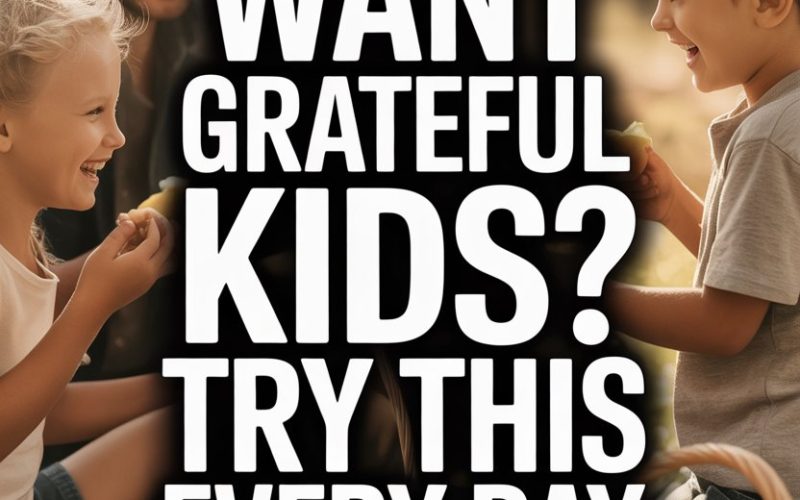Picture this: You spend hours prepping dinner, someone under four feet tall grimaces at their plate, and when you mention there are children across the globe who’d love a bite, you’re met with a sigh and an expertly executed eye roll.
Gratitude, it seems, has left the building.
Can kids these days learn to appreciate what they have—beyond that sacred iPad charging cable? Absolutely. And, surprisingly, you don’t need a holiday or life-changing event to spark it.
Grateful children aren’t born, they’re raised, gently and consistently, one ordinary day at a time.
Here’s how you can build gratitude into everyday family life—even when you’re running on three hours’ sleep and caffeine fumes.
Model Gratitude Like It’s Your Side Hustle
Children have built-in radar for detecting hypocrisy. “Do as I say, not as I do” never really flew, did it? If you want gratitude to take root, it starts with your own habits.
Thank your partner for packing lunch. Express appreciation when your child helps—even if “help” meant spilling flour on every surface in a two-metre radius.
Voice thanks for the little things: the sun shining, your tea staying warm for ten consecutive minutes, the bin actually getting taken out.
Research confirms that parents who regularly express gratitude raise children who do the same. According to psychologist Jeffrey Froh, children as young as six notice and mimic the ways adults show thanks.
You don’t have to channel Pollyanna. A simple “I’m so glad you remembered to feed the dog” or “I appreciate you bringing your shoes to the door, not leaving them in the hallway booby-trap” will do.
Make Gratitude a Ritual, Not a Random Act
Manners are grand, but gratitude is much more than a reflexive “thank you.”
Rituals help children pause and notice the good stuff—even on days when socks go missing and tempers run hot.
Try a quick gratitude round at dinner. Everyone shares one thing they appreciated about their day, no matter how small. (Yes, “Recess” or “When the maths lesson ended” counts.)
For tiny ones, a bedtime ritual can work wonders. Tuck-in chats about what made them smile today—be it a friendly classmate or surviving broccoli at lunch—get kids into the habit of scanning for silver linings.
Gratitude journals aren’t just for Instagram influencers. A family notebook, scribbled in once or twice a week, can help reinforce the habit.
The key? Keep it low-pressure. No one needs another thing on their to-do list that leads to parental guilt.
Let Them Give and Help—Even If It’s Messy
Kids are grateful when they see themselves as givers, not just receivers. That doesn’t mean you need to organize a charity gala in your lounge room every Thursday. Start small.
Invite kids to help pack up their old toys for donation. Ask them to pick a few tins for the local food drive.
Tasks like these foster empathy—and an awareness of their own abundance—without lectures or heavy-handed lessons.
A little autonomy sweetens the deal. When kids help choose what to give, or how to help, the impact sinks in.
According to research from the University of California, Davis, children who actively participate in acts of giving are far more likely to feel grateful.
Yes, this can get messy. (Picture a five-year-old “helping” wrap gifts for charity with enough sticky tape to seal a moon landing.) But the payoff is worth every sticky finger.
Normalise Thank-You Notes—Even the Wonky Ones
Yes, snail mail still exists, and it’s an underappreciated route to gratitude. Thank-you notes—written, drawn, or dictated—remind children to pause and reflect on the kindness they’ve received.
For little ones, a scribbled drawing for Grandma or a dictated message to a helpful neighbour counts. Tweens and teens can send a quick text or email; there’s no need for calligraphy or a Shakespearean sonnet.
Don’t worry if those notes look more like abstract art than legible words. It’s the process that matters.
Turning gratitude into action—through a note, a call, or a homemade card—cements it in memory.
Resist the Urge to “Fix” Every Disappointment
Modern parenting comes with a side order of guilt. When children grumble about not getting the latest gadget or the shiniest trainers, it’s tempting to swoop in with solutions.
But gratitude grows in the gaps—those moments when things don’t go exactly to plan, and the world doesn’t magically rearrange itself to meet every whim.
Acknowledge their feelings (“It’s tough when you want something and can’t have it right away”), but resist the urge to rush in as the family genie.
Children who learn to sit with disappointment develop a deeper appreciation for what they do have.
This isn’t about being stingy or cruel. It’s about helping children realise that happiness and gratitude aren’t always linked to getting more, but to noticing what’s already in their corner.
Tell Family Stories—the Real Kind
Children adore tales of when Mum wore questionable 80s fashions or Dad got lost on public transport. These family stories, peppered with humour and humility, are more than just entertainment.
Share memories of times when things were scarce, when you worked for something, or when a small kindness changed your day.
Stories give gratitude context—they show how far you’ve come, and that the good things weren’t always a given.
Psychologists have found that family storytelling builds resilience and gratitude in children.
The Emory University “Do You Know?” study showed that children who know their family’s ups and downs feel more connected, capable, and—yes—grateful.
No need to spin a heroic saga out of every stubbed toe. Just sprinkle stories into car rides, bedtime, or while folding what feels like your thousandth load of laundry.
Celebrate Small Wins—And Not Just the Trophies
Everyone loves a big milestone. But if you’re waiting for top marks, gold medals, or perfectly behaved siblings before breaking out the warm fuzzies, you’ll be waiting a while.
Notice the micro-moments: a child who shares the last biscuit, offers a hug after a tough day, or finally remembers to say “please” unprompted. (Miracles do happen.)
Point out these moments aloud. “I saw you waited your turn even though you were excited—that was kind.” It may feel awkward at first, but children soak up this attention like sponges.
Celebrating small acts creates a gratitude feedback loop.
Dr. Robert Emmons, a leading gratitude researcher, found that acknowledging children’s efforts in the moment increases the likelihood they’ll repeat them.
Avoid Gratitude as a Chore or Guilt Trip
No one likes gratitude with a side of guilt. “You should be grateful—you have so much!” has never inspired true appreciation in any child (or adult).
Instead, create a home where gratitude is noticed, not demanded. Invite children to reflect, but let them lead.
If they’re having a rough day, don’t force sunshine and rainbows. Sometimes, gratitude takes time to land.
Keep your tone light. Sarcasm can be funny, but make sure it doesn’t slide into shaming. Gratitude is a habit, not a performance.
Embrace Imperfection—Yours and Theirs
Some evenings, you’ll forget to ask about gratitude, and the only thing your child will thank you for is extra screen time. That’s normal.
Building lasting habits takes time, patience, and a sense of humour. You’re raising a human, not programming a gratitude robot.
Progress isn’t measured in flawless thank-you notes or choreographed acts of appreciation.
Notice the tiny shifts: a thank-you muttered instead of whined, a rare moment of sharing, a spontaneous hug. These are the seeds of gratitude—and they grow, slowly but surely, with daily practice.
Why Gratitude Is Worth the Effort (Even on Chaotic Days)
Raising a grateful child isn’t about raising a perfectly polite, never-complaining automaton.
It’s about helping your child see the colour in their own lives, to value connection over consumption, and to weather disappointment with resilience.
Research shows that children who practice gratitude are happier, healthier, and able to cope better when life throws curveballs their way.
They’re more likely to thrive socially and academically, and—dare we say it—make your job a smidge easier in the long run.
Gratitude, it turns out, isn’t just good manners. It’s emotional armour, a happiness booster, and the secret ingredient for a close-knit family.
The Power of Small, Everyday Moments
No one expects you to add “gratitude coach” to your CV. Shaping grateful kids happens in the ordinary moments: at the dinner table, on the school run, or during those impromptu chats before lights-out.
Try one gratitude ritual tonight. Keep it simple, keep it genuine, and watch as small shifts begin to take hold.
You may not get a thank-you note for your efforts (yet), but one day—between the mess, the noise, and the endless laundry—you’ll catch your child pausing, smiling, and saying, “Thanks.”
That’s when you’ll know: it worked.





